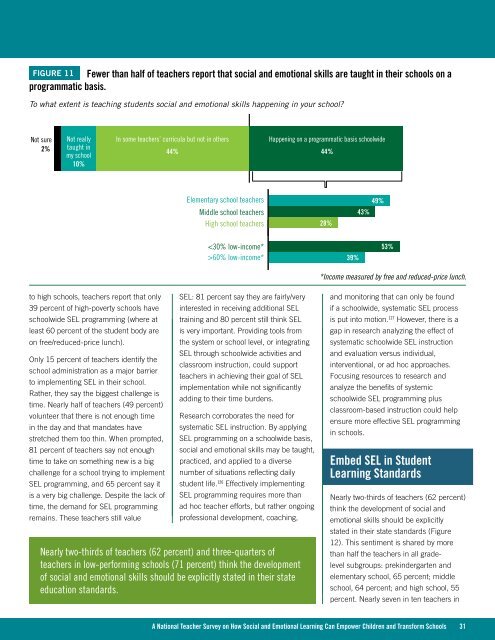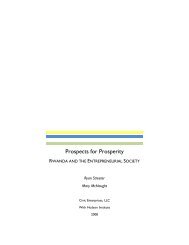The Missing Piece - Civic Enterprises
The Missing Piece - Civic Enterprises
The Missing Piece - Civic Enterprises
You also want an ePaper? Increase the reach of your titles
YUMPU automatically turns print PDFs into web optimized ePapers that Google loves.
Figure 11 Fewer than half of teachers report that social and emotional skills are taught in their schools on aprogrammatic basis.To what extent is teaching students social and emotional skills happening in your school?Not sure2%Not reallytaught inmy school10%In some teachers’ curricula but not in others44%Happening on a programmatic basis schoolwide44%Elementary school teachersMiddle school teachersHigh school teachers28%28%49%43%49%43%to high schools, teachers report that only39 percent of high-poverty schools haveschoolwide SEL programming (where atleast 60 percent of the student body areon free/reduced-price lunch).Only 15 percent of teachers identify theschool administration as a major barrierto implementing SEL in their school.Rather, they say the biggest challenge istime. Nearly half of teachers (49 percent)volunteer that there is not enough timein the day and that mandates havestretched them too thin. When prompted,81 percent of teachers say not enoughtime to take on something new is a bigchallenge for a school trying to implementSEL programming, and 65 percent say itis a very big challenge. Despite the lack oftime, the demand for SEL programmingremains. <strong>The</strong>se teachers still value60% low-income*SEL: 81 percent say they are fairly/veryinterested in receiving additional SELtraining and 80 percent still think SELis very important. Providing tools fromthe system or school level, or integratingSEL through schoolwide activities andclassroom instruction, could supportteachers in achieving their goal of SELimplementation while not significantlyadding to their time burdens.Research corroborates the need forsystematic SEL instruction. By applyingSEL programming on a schoolwide basis,social and emotional skills may be taught,practiced, and applied to a diversenumber of situations reflecting dailystudent life. 126 Effectively implementingSEL programming requires more thanad hoc teacher efforts, but rather ongoingprofessional development, coaching,Nearly two-thirds of teachers (62 percent) and three-quarters ofteachers in low-performing schools (71 percent) think the developmentof social and emotional skills should be explicitly stated in their stateeducation standards.53%39%53%39%*Income measured by free and reduced-price lunch.and monitoring that can only be foundif a schoolwide, systematic SEL processis put into motion. 127 However, there is agap in research analyzing the effect ofsystematic schoolwide SEL instructionand evaluation versus individual,interventional, or ad hoc approaches.Focusing resources to research andanalyze the benefits of systemicschoolwide SEL programming plusclassroom-based instruction could helpensure more effective SEL programmingin schools.Embed SEL in StudentLearning StandardsNearly two-thirds of teachers (62 percent)think the development of social andemotional skills should be explicitlystated in their state standards (Figure12). This sentiment is shared by morethan half the teachers in all gradelevelsubgroups: prekindergarten andelementary school, 65 percent; middleschool, 64 percent; and high school, 55percent. Nearly seven in ten teachers inA National Teacher Survey on How Social and Emotional Learning Can Empower Children and Transform Schools 31









